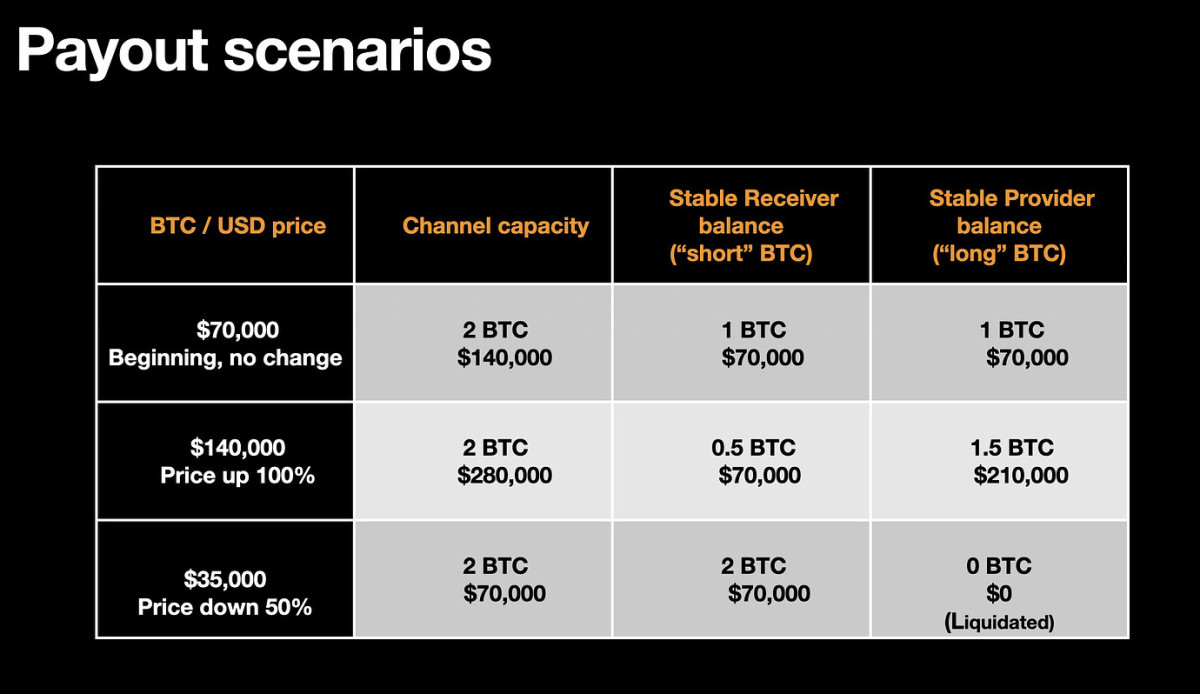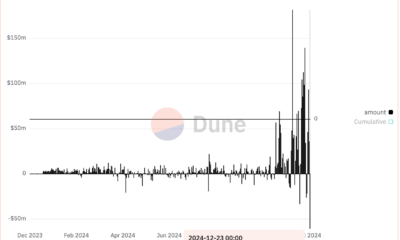Opinion
Bitcoin’s Future in Payments: Overcoming Stablecoin Dominance with Fiatless Fiat
Published
3 months agoon
By
admin
Stablecoins have so far dominated the crypto payment market, but some Bitcoin developers believe there’s a proposal out there that could offer a legitimate alternative.
Seven years ago, Dorier, a long-time developer, set out to democratize bitcoin payment processing by launching a free and open-source alternative to the then-dominant BitPay: BTCPay Server. Today, despite the project’s strong grassroots success among Bitcoin enthusiasts and online merchants, the landscape of cryptocurrency payments has evolved dramatically from when Dorier first began his journey. The rise of stablecoins has quickly dominated the space, pushing bitcoin—the world’s largest digital asset—to the sidelines in the payment processing arena.
Fueled by growing demand for stable currency options, particularly US dollars, stablecoins have swiftly taken over the cryptocurrency payments market. This surge has left many Bitcoin enthusiasts struggling to cope with the reality that these dollar-pegged assets could reinforce the very system Bitcoin was designed to challenge—the hegemony of the US dollar. As stablecoins continue to gain traction, Bitcoin promoters find themselves at a crossroads, questioning how to preserve Bitcoin’s vision of financial sovereignty in a market increasingly leaning toward stability over decentralization.
A new proposal emerging from the Lightning ecosystem has caught Dorier’s attention, and the veteran developer believes it could address this obstacle. Speaking to a packed audience at BTCPay Server’s recent annual community gathering in Riga, Dorier introduced the concept of “fiatless fiat”—a Bitcoin-native alternative to treasury-backed stablecoins like Tether and USDC.
Synthetic USD
Back in 2015, BitMEX co-founder and then-CEO Arthur Hayes outlined in a blog post how to use futures contracts to create synthetic US dollars. Although this idea never gained widespread traction, it became a popular strategy among traders seeking to hedge against bitcoin’s volatility without having to sell their underlying bitcoin positions.
For readers less familiar with financial derivatives, a synthetic dollar (or synthetic position) can be created by two parties entering a contract to speculate on the price movement of an underlying asset—in this case, bitcoin. Essentially, by taking an opposite position to their bitcoin holdings in a futures contract, traders can protect themselves from price swings without having to sell their bitcoin or rely on a US dollar instrument.
More recently, services like Blink Wallet have adopted this concept through the Stablesats protocol. Stablesats allows users to peg a portion of their bitcoin balance to a fiat currency, such as the US dollar, without converting it into traditional currency. In this model, the wallet operator acts as a “dealer” by hedging the user’s pegged balance using futures contracts on centralized exchanges. The operator then tracks the respective liabilities, ensuring that the user’s pegged balance maintains its value relative to the chosen currency. (More detailed information about the mechanism can be found on the Stablesats website.)
Obviously, this setup comes with a significant trade-off. By using Stablesats or similar services, users effectively relinquish custody of their funds to the wallet operator. The operator must then manage the hedging process and maintain the necessary contracts to preserve the synthetic peg.
Stable channels and virtual balances
In Riga, Dorier pointed out that a similar effect can be achieved between two parties using a different type of contract: Lightning channels. The idea follows recent work from Bitcoin developer Tony Klaus on a mechanism called stable channels.
Instead of relying on centralized exchanges, stable channels connect users seeking to hedge their Bitcoin exposure with ‘stability providers’ over the Lightning network. A stable channel essentially functions as a shared Bitcoin balance, where funds are allocated according to the desired exposure of the ‘stability receiver.’ Leveraging Lightning’s rapid settlement capabilities, the balance can be continuously adjusted in response to price fluctuations, with sats shifting to either side of the channel as needed to maintain the agreed distribution.
Here’s a simple chart to illustrate what the fund’s breakdown may look like over time:

Clearly, this strategy entails considerable risks. As illustrated above, stability providers taking leveraged long positions on the exchange are exposed to large downside price volatility. Moreover, once the reserves of these stability providers are exhausted, users aiming to lock in their dollar-denominated value will no longer be able to absorb further price declines. While those types of rapid drawdowns are increasingly rare, Bitcoin’s volatility is always unpredictable and it’s conceivable that stability providers may look to hedge their risks in different ways.
On the other hand, the structure of this construct allows participants’ exposure within the channel to be linked to any asset. Provided both parties independently agree on a price, this can facilitate the creation of virtual balances on Lightning, enabling users to gain synthetic exposure to a variety of traditional portfolio instruments, such as stocks and commodities, assuming these assets maintain sufficient liquidity. Researcher Dan Robinson originally proposed an elaborated version of this idea under the name Rainbow Network.
The good, the bad, the ugly
The concept of “fiatless fiat” and stable channels is compelling because of its simplicity. Unlike algorithmic stablecoins that rely on complex and unsustainable economic models involving exogenous assets, the Bitcoin Dollar, as envisioned by Dorier and others, is purely the result of a voluntary, self-custodial agreement between two parties.
This distinction is critical. Stablecoins usually involve a centralized governing body overseeing a global network, while a stable channel is a localized arrangement where risk is contained to the participants involved. Interestingly, it does not even have to rely on network effects: one user can choose to receive USD-equivalent payments from another, and subsequently shift the stability contract to a different provider at their discretion. Stability provision has the potential to become a staple service from various Lightning Service Provider types of entities competing and offering different rates.
This focus on local interactions helps mitigate systemic risk and fosters an environment more conducive to innovation, echoing the original end-to-end principles of the internet.
The protocol allows for a range of implementations and use cases, tailored to different user groups, while both stability providers and receivers maintain full control over their underlying bitcoin. No third party—not even an oracle—can confiscate a user’s funds. Although some existing stablecoins offer a degree of self-custody, they by contrast remain vulnerable to censorship, with operators able to blacklist addresses and effectively render associated funds worthless.
Unfortunately, this approach also inherits several challenges and limitations inherent to self-custodial systems. Building on Lightning and payment channels introduces online requirements, which have been cited as barriers to the widespread adoption of these technologies. Because stable channels monitor price fluctuations through regular and frequent settlements, any party going offline can disrupt the maintenance of the peg, leading to potential instability. In an article further detailing his thoughts on the idea, Dorier entertains various potential solutions to a party going offline, mainly insisting that re-establishing the peg of funds already allocated to a channel “is a cheap operation.”
Another potentially viable solution to the complex management of the peg involves the creation of ecash mints, which would issue stable notes to users and handle the channel relation with the stability provider. This approach already has real-world implementations and could see more rapid adoption due to its superior user experience. The obvious tradeoff is that custodial risks are reintroduced into a system designed to eliminate them. Still, proponents of ecash argue that its strong privacy and censorship-resistant properties make it a vastly superior alternative to popular stablecoins, which are prone to surveillance and control.
Beyond this, the complexity of the Lightning protocol and the inherent security challenges posed by keeping funds at risk in “hot” channels will need careful consideration when scaling operations.
Perhaps the most pressing challenge for this technology is the dynamic nature of the peg, which may attract noncooperative actors seeking to exploit short-term, erratic price movements. Referred to as the “free-option problem,” a malicious participant could cease honoring the peg, leaving their counterparties exposed to volatility and the burden of reestablishing a peg with another provider. In a post on the developer-focused Delving Bitcoin forum, stable channel developer Tony Klaus outlines several strategies to mitigate this issue, offering potential safeguards against these types of opportunistic behaviors.
While no silver bullet exists, the emergence of a market for stability providers could potentially foster reputable counterparties whose long-term business interests will outweigh the short-term gains of defrauding users. As competition increases, these providers will have strong incentives to maintain trust and reliability, creating a more robust and dependable ecosystem for users seeking stability in their transactions.
Concluding his presentation in Riga, Dorier acknowledged the novelty of this experiment but encouraged attendees to also consider its enticing potential.
“It’s very far-fetched, it’s a new idea. It’s a new type of money. You need new business models. You need new protocols and new infrastructure. It’s something more long-term, more forward-looking.”
Users and developers interested to learn or contribute to the technology can find more information on the website or through the public Telegram channel.
Source link
You may like


SCENE’s 2024 Person of the Year: Iggy Azalea


BTC Risks Falling To $20K If This Happens


Most Layer 2 solutions are still struggling with scalability


Here’s why Stellar Price Could Go Parabolic Soon


Perp-Focused HyperLiquid Experiences Record $60M in USDC Net Outflows


Experts say these 3 altcoins will rally 3,000% soon, and XRP isn’t one of them
Blockchain
Most Layer 2 solutions are still struggling with scalability
Published
3 hours agoon
December 23, 2024By
admin
Disclosure: The views and opinions expressed here belong solely to the author and do not represent the views and opinions of crypto.news’ editorial.
Since pivoting to a layer 2-centric approach, the Ethereum (ETH) ecosystem has relied heavily on L2 solutions to scale. However, these solutions are struggling to compete effectively, especially under pressure from alternatives like Solana (SOL). During the recent meme coin craze, Solana attracted much of the activity due to its advantages: low fees, high transaction speed, and user-friendliness.
To understand the challenges, it’s essential to examine why L2 solutions have not demonstrated the scalability and cost advantages that were widely anticipated.
Why meme projects favor Solana over Ethereum L2s
Meme projects have significantly contributed to the recent surge in market activity. These projects favor Solana for several reasons beyond user-friendliness:
- Low fees: Solana’s low transaction costs make it ideal for fee-sensitive applications like memecoins.
- High speed: Solana’s multithreaded architecture enables high throughput, ensuring seamless user experiences.
- Better developer experience: Solana’s tools and ecosystem are optimized for ease of use, attracting developers and projects.
Why is scalability important?
Scalability is fundamentally measured by the number of transactions a blockchain can process. A highly scalable blockchain can handle more TXs while offering lower fees, making it crucial for widespread adoption and maintaining a seamless user experience.
This is especially important for grassroots projects like meme coins, many of which are short-lived and highly fee-sensitive. Without scalability, these projects cannot thrive, and users will migrate to platforms that offer better efficiency and cost-effectiveness.
Why Ethereum L2s aren’t up to the challenge
Architectural limitations of Ethereum. Ethereum has long faced scalability issues, and L2 rollups are its primary solution to these problems. L2s operate as independent blockchains that process transactions off-chain while posting transaction results and proofs back to Ethereum’s mainnet. They inherit Ethereum’s security, making them a promising scaling approach.
However, Ethereum’s original design poses inherent challenges. Ethereum’s founder, Vitalik Buterin, has admitted that “Ethereum was never designed for scalability.” One of the key limitations is the lack of multithreading in the Ethereum Virtual Machine. The EVM, which processes transactions, is strictly single-threaded, meaning it can handle only one transaction at a time. In contrast, Solana’s multithreaded architecture allows it to process multiple transactions simultaneously, significantly increasing throughput.
L2s inheriting Ethereum’s limitations. Virtually all L2 solutions inherit Ethereum’s single-threaded EVM design, which results in low efficiency. For instance, Arbitrum: With a targeted gas limit of 7 million per second and each coin transfer costing 21,000 gas, Arbitrum can handle about 333 simple transactions per second. More complex smart contract calls consume even more gas, significantly reducing capacity. Optimism: With a gas limit of 5 million per block and a block time of 2 seconds, Optimism can handle only about 119 simple transfers per second. Gas-intensive operations further reduce this capacity.
Unstable fees. Another major issue with Ethereum and its L2 solutions is unstable fees during periods of high network activity. For applications relying on low and stable fees, this is a critical drawback. Projects like meme coins are especially fee-sensitive, making Ethereum-based L2s less attractive.
Lack of interoperability between L2s. The scalability argument for having multiple L2s only holds if contracts on different L2s can interact freely. However, rollups are essentially independent blockchains, and accessing data from one rollup to another is as challenging as cross-chain communication. This lack of interoperability significantly limits the potential of L2 scalability.
What can L2s do to further scale?
Embed features to enhance interoperability. Ethereum L1 needs to do more to support interoperability among L2s. For example, the recent ERC-7786: Cross-Chain Messaging Gateway is a step in the right direction. While it doesn’t fully resolve the interoperability issue, it simplifies communication between L2s and L1, laying the groundwork for further improvements.
Architectural updates: Diverge from the existing L1 design. To compete with multithreaded blockchains like Solana, L2s must break free from Ethereum’s single-threaded EVM design and adopt parallel execution. This may require a complete overhaul of the EVM, but the potential scalability gains make it a worthwhile endeavor.
Future milestones
Ethereum’s L2 solutions face significant challenges in delivering the scalability and cost-effectiveness that applications like meme coins demand. To stay competitive, the ecosystem must address fundamental architectural limitations, enhance interoperability, and embrace innovations in blockchain design. Only by doing so can Ethereum L2s achieve the scalability needed to support widespread adoption and fend off competition from emerging blockchains like Solana.

Laurent Zhang
Laurent Zhang is the president and founder of Arcology Network, a revolutionizing Ethereum layer-2 solution with the first-ever EVM-equivalent, multithreaded rollup—offering unparalleled performance and efficiency for developers building the next generation of decentralized applications. With an executive leadership and innovation background, Laurent holds a degree from Oxford Brookes University. Laurent’s professional journey includes over a decade of experience in science, research, engineering, and leadership roles. After graduating in 2005, he joined MKS Instruments as an Algorithm Engineer. From 2010 to 2012, he worked as a research engineer at the Alberta Machine Intelligence Institute, followed by a position as a research scientist at Baker Hughes from 2012 to 2014. He then served as vice president of engineering at Quikflo Health between 2016 and 2018. Since 2017, Laurent has been the president of Arcology Network, being a visionary of a future where blockchain technology reaches its full potential, offering unmatched scalability, efficiency, and innovation.
Source link



Recently, BlackRock released an educational video explaining Bitcoin, which I thought was great—it’s amazing to see Bitcoin being discussed on such a massive platform. But, of course, Bitcoin X (Twitter) had a meltdown over one specific line in the video: “There is no guarantee that Bitcoin’s 21 million supply cap will not be changed.”
HealthRnager from Natural News claimed, “Bitcoin has become far too centralized, and now the wrong people largely control its algorithms. They are TELLING you in advance what they plan to do.”
Now, let me be clear: this is total nonsense. The controversy is overhyped, and the idea that BlackRock would—or even could—change bitcoin’s supply is laughable. The statement in their video is technically true, but it’s just a legal disclaimer. It doesn’t mean BlackRock is plotting to inflate bitcoin’s supply. And even if they were, they don’t have the power to pull it off.
Bitcoin’s 21 million cap is fundamental—it’s not up for debate. The entire Bitcoin ecosystem—miners, developers, and nodes—operates on this core principle. Without it, Bitcoin wouldn’t be Bitcoin. And while BlackRock is a financial giant and holds over 500,000 Bitcoin for its ETF, its influence over Bitcoin is practically nonexistent.
Bitcoin is a proof-of-work (PoW) system, not a proof-of-stake (PoS) system. It doesn’t matter how much bitcoin BlackRock owns; economic nodes hold the real power.
Let’s play devil’s advocate for a second. Say BlackRock tries to propose a protocol change to increase bitcoin’s supply. What happens? The vast network of nodes would simply reject it. Bitcoin’s history proves this. Remember Roger Ver and the Bitcoin Cash fork? He had significant influence and holdings, yet his version of bitcoin became irrelevant because the majority of economic actors didn’t follow him.
If Bitcoin could be controlled by a single entity like BlackRock, it would’ve failed a long time ago. The U.S. government, with its endless money printer, could easily acquire 10% of the supply if that’s all it took to control Bitcoin. But that’s not how Bitcoin works. Its decentralized nature ensures no single entity—no matter how powerful—can dictate its terms.
So, stop worrying about BlackRock “changing” Bitcoin. Their influence has hard limits. Even if they tried to push developers to change the protocol, nodes would reject it. Bitcoin’s decentralization is its greatest strength, and no one—not BlackRock, not Michael Saylor—can change that.
This article is a Take. Opinions expressed are entirely the author’s and do not necessarily reflect those of BTC Inc or Bitcoin Magazine.
Source link
Opinion
It’s Time to Admit It – There Are Only 2.1 Quadrillion Bitcoins
Published
2 days agoon
December 21, 2024By
admin
If the above statement offends you, you might not have read the Bitcoin source code.

https://x.com/pete_rizzo_/
Of course, I’m sure you’ve heard that there are 21 million bitcoin – and this is true, the Bitcoin protocol allows for only “21 million bitcoin” to be created, yet these larger denominations can be subdivided into 100 million sub-units each.
Call them whatever you want, there are only 2.1 quadrillion monetary units in the protocol.
This dollars and cents differential has long been the subject of debate – in the time of Satoshi, Bitcoin’s creator, the dual conventions, Bitcoin having both a bulk denomination, and a smaller unit, was not much of a concern. There were questions about whether the software would work at all, and bitcoin were so worthless, selling them in bulk was the only rational option.
Rehashing this debate is BIP 21Q, a proposal to the Bitcoin users authored by John Carvalho, founder of Synonym, creator of the Pubky social media platform, and a tenured contributor whose work dates back to the days of the influential Bitcoin-assets collective.
In short, the BIP proposes that network actors – the various wallets and exchanges – change how Bitcoin denominations are displayed, with the smallest unit of the protocol renamed “bitcoins,” as opposed to “satoshis,” as they have been commonly called.
Here are the specifics of the BIP:
Redefinition of the Unit:
- Internally, the smallest indivisible unit remains unchanged.
- Historically, 1 BTC = 100,000,000 base units. Under this proposal, “1 bitcoin” equals that smallest unit.
- What was previously referred to as “1 BTC” now corresponds to 100 million bitcoins under the new definition.
Terminology:
- The informal terms “satoshi” or “sat” are deprecated.
- All references, interfaces, and documentation SHOULD refer to the base integer unit simply as “bitcoin.”
Display and Formatting:
- Applications SHOULD present values as whole integers without decimals.
- Example:
- Old display: 0.00010000 BTC
- New display: 10000 BTC (or ₿10000)
Unsurprisingly, the debate around the BIP has been hostile. For one, it’s not a technical BIP, though this is not a requirement of the BIP process. Suffice to say, it’s perhaps the most general BIP that has been proposed under the BIP process to date, as it mainly deals with market conventions and user onboarding logic, not any changes to the software rules.
However, I have to say, I find the proposal compelling. Nik Hoffman, our News Editor, does not, preferring to stick to the market affirmative.
Yet, I think the proposal raises relevant questions: why should new users be forced to compute their Bitcoin balances using only decimals? Surely this has the adverse side effect of making commerce difficult – it’s simply antithetical to how people think and act today.
Also, in terms of savings, at an $100,000 BTC price, it isn’t exactly compelling to think you could be spending a whole year earning 1 BTC, though that may be.
Indeed, there have been various debates for all kinds of units – mBTC, uBTC – that play around with the dollars and cents convention, but Carvalho here is wisely skipping to the end, preferring just to rip the band-aid off. $1 would buy 1,000 bitcoins under his proposal.
What’s to like here, and I argued this during a Lugano debate on the topic in 2023, is that it keeps both the larger BTC denomination and the smaller unit, now bitcoins. They are both important, and serve different functions.
My argument then was that having a larger denomination like BTC (100 million bitcoins) is important. If there was no “BTC unit,” the press and financial media would be faced to reckon that “1 bitcoin” is still worth less than 1 cent.
How much mainstream coverage and interest do we think there would be? I’d bet not very much.
In this way, BIP 21Q is a best-of-both-worlds approach.
The financial world, press, and media can continue championing the meteoric rise in value of “BTC,” while everyday users can get rid of decimals and complex calculations, trading the only real Bitcoin unit guaranteed to exist in perpetuity.
This article is a Take. Opinions expressed are entirely the author’s and do not necessarily reflect those of BTC Inc or Bitcoin Magazine.
Source link

SCENE’s 2024 Person of the Year: Iggy Azalea

BTC Risks Falling To $20K If This Happens

Most Layer 2 solutions are still struggling with scalability

Here’s why Stellar Price Could Go Parabolic Soon

Perp-Focused HyperLiquid Experiences Record $60M in USDC Net Outflows

Experts say these 3 altcoins will rally 3,000% soon, and XRP isn’t one of them

Robert Kiyosaki Hints At Economic Depression Ahead, What It Means For BTC?

BNB Steadies Above Support: Will Bullish Momentum Return?

Metaplanet makes largest Bitcoin bet, acquires nearly 620 BTC

Tron’s Justin Sun Offloads 50% ETH Holdings, Ethereum Price Crash Imminent?

Investors bet on this $0.0013 token destined to leave Cardano and Shiba Inu behind

End of Altcoin Season? Glassnode Co-Founders Warn Alts in Danger of Lagging Behind After Last Week’s Correction

Can Pi Network Price Triple Before 2024 Ends?

XRP’s $5, $10 goals are trending, but this altcoin with 7,400% potential takes the spotlight

CryptoQuant Hails Binance Reserve Amid High Leverage Trading
182267361726451435

Why Did Trump Change His Mind on Bitcoin?

Top Crypto News Headlines of The Week

New U.S. president must bring clarity to crypto regulation, analyst says

Will XRP Price Defend $0.5 Support If SEC Decides to Appeal?

Bitcoin Open-Source Development Takes The Stage In Nashville

Ethereum, Solana touch key levels as Bitcoin spikes

Bitcoin 20% Surge In 3 Weeks Teases Record-Breaking Potential

Ethereum Crash A Buying Opportunity? This Whale Thinks So

Shiba Inu Price Slips 4% as 3500% Burn Rate Surge Fails to Halt Correction

Washington financial watchdog warns of scam involving fake crypto ‘professors’

‘Hamster Kombat’ Airdrop Delayed as Pre-Market Trading for Telegram Game Expands

Citigroup Executive Steps Down To Explore Crypto
Mostbet Güvenilir Mi – Casino Bonus 2024

NoOnes Bitcoin Philosophy: Everyone Eats
Trending

 3 months ago
3 months ago182267361726451435

 Donald Trump5 months ago
Donald Trump5 months agoWhy Did Trump Change His Mind on Bitcoin?

 24/7 Cryptocurrency News4 months ago
24/7 Cryptocurrency News4 months agoTop Crypto News Headlines of The Week

 News4 months ago
News4 months agoNew U.S. president must bring clarity to crypto regulation, analyst says

 Price analysis4 months ago
Price analysis4 months agoWill XRP Price Defend $0.5 Support If SEC Decides to Appeal?

 Opinion5 months ago
Opinion5 months agoBitcoin Open-Source Development Takes The Stage In Nashville

 Bitcoin5 months ago
Bitcoin5 months agoEthereum, Solana touch key levels as Bitcoin spikes

 Bitcoin5 months ago
Bitcoin5 months agoBitcoin 20% Surge In 3 Weeks Teases Record-Breaking Potential


